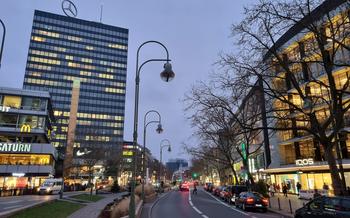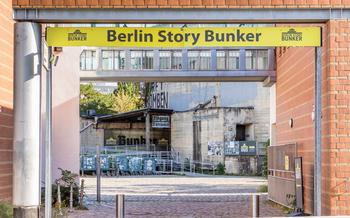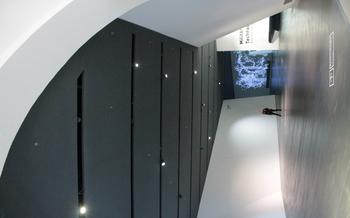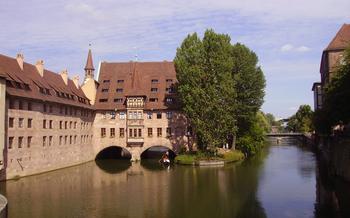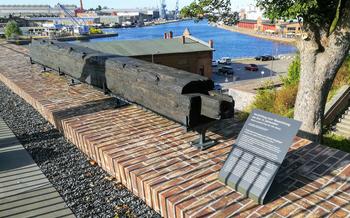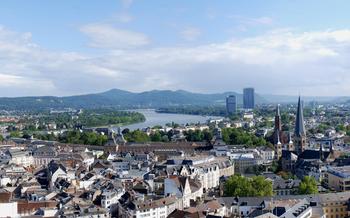
Bochum Central Cemetery
- Bochum Central Cemetery: A Monumental City of the Dead
- Location and Accessibility
- Historical Overview
- Cultural Significance
- Notable Burials
- Self-Guided Tours
- Guided Tours
- Events and Exhibitions
- Photography and Videography
- Research and Genealogy
- Conservation and Restoration
- Educational Programs: Unveiling History, Culture, and Mortality
- Accessibility and Inclusivity
- Insider Tip: Hidden Gems
Bochum Central Cemetery: A Monumental City of the Dead
Bochum Central Cemetery, with its rich historical significance, stands as a monumental city of the dead. Established in 1878, it bears witness to Bochum's history, showcasing architectural marvels that blend seamlessly with the cultural legacy of the region. The cemetery serves as the final resting place for notable figures from various walks of life, paying homage to their contributions to society. Explore this realm beyond life, where art, architecture, and history intertwine, creating a profound and thought-provoking experience.
Location and Accessibility
The Bochum Central Cemetery is conveniently situated at the address Am Engelsberg 125, 44793 Bochum, Germany. Its central location makes it easily accessible by various means of transportation.
Public transportation: Several bus lines have stops near the cemetery, including the 344, 354, 364, and 365 buses. Visitors can also take the U-Bahn (subway) to the Bochum Hauptbahnhof (main train station) and then transfer to the 344 bus, which will take them directly to the cemetery.
Parking: For those arriving by car, there are ample parking spaces available near the cemetery. Visitors can park on the streets surrounding the cemetery or in the designated parking lot located at the main entrance.
Operating hours: The Bochum Central Cemetery is open to the public daily from 8:00 AM to 6:00 PM. However, it is important to note that the operating hours may vary during holidays or special events. Visitors are advised to check the cemetery's website or contact the cemetery office for the most up-to-date information on operating hours.
Historical Overview
The Bochum Central Cemetery, steeped in history, traces its origins back to the late 19th century when the city's growing population necessitated a new burial ground. In 1898, the cemetery was consecrated and began receiving its first burials. Over the years, it expanded to accommodate the increasing number of deceased, becoming a significant part of Bochum's urban landscape.
World War II left an indelible mark on the cemetery. Allied bombings during the war damaged several chapels and mausoleums, leaving behind a legacy of destruction. However, the post-war period witnessed a remarkable effort to restore and rebuild the cemetery. With the help of dedicated individuals and organizations, the damaged structures were repaired, and the grounds were meticulously restored to their former glory.
Today, the Bochum Central Cemetery stands as a testament to the city's resilience and its commitment to preserving its heritage. Recognized as a cultural and historical landmark, it attracts visitors from near and far who come to pay their respects, explore its rich history, and appreciate its architectural marvels.
Cultural Significance
The Bochum Central Cemetery is not just a burial ground but also a repository of Bochum's rich history and culture. It reflects the changing societal attitudes towards death and the integration of art, architecture, and nature. The cemetery has become a symbol of Bochum's identity, a place where the past and present intertwine, and where art and history converge.
The cemetery's cultural significance lies in its ability to tell the story of Bochum's development through its diverse collection of graves and monuments. It is a testament to the city's industrial heritage, its artistic achievements, and its social and political struggles. The graves of war heroes and victims of persecution serve as a reminder of the city's resilience and the sacrifices made by its citizens.
The Bochum Central Cemetery is also a place where art and nature converge. The cemetery's landscaped gardens, towering trees, and intricate sculptures create a unique and serene atmosphere. The integration of art and architecture is evident in the elaborate mausoleums and chapels, which showcase a variety of artistic styles, from Neoclassical to Art Nouveau.
The cemetery's cultural significance extends beyond its physical boundaries. It has become a venue for cultural events and exhibitions, such as concerts, theater performances, and art exhibitions. These events bring the cemetery to life, transforming it into a vibrant cultural space that encourages dialogue and reflection on themes of mortality, history, and art.
Notable Burials
The Bochum Central Cemetery is the final resting place of numerous notable figures who have left an indelible mark on Bochum's history, culture, and industry. Among them lies Fritz Heinemann, the renowned architect responsible for designing many of Bochum's iconic buildings, including the Schauspielhaus and the Jahrhunderthalle. His grave, adorned with an intricate Art Nouveau sculpture, stands as a testament to his enduring legacy.
Another prominent figure interred here is Heinrich Kämpchen, a pioneering industrialist who revolutionized the steel industry in Bochum. His mausoleum, an opulent Neoclassical structure, reflects the wealth and influence he amassed during his lifetime. Visitors can also pay their respects to Otto Hue, a beloved actor and director who graced the stages of Bochum's Schauspielhaus for over four decades. His grave, marked by a simple yet elegant headstone, is a reminder of his contributions to the city's thriving theater scene.
The cemetery also holds the remains of war heroes and victims of persecution. One poignant grave belongs to Wilhelm Fernholz, a young soldier who lost his life during World War I. His headstone, etched with a heart-wrenching poem, serves as a reminder of the devastating toll that war takes on individuals and families. Standing in solidarity with Fernholz is a memorial to the victims of Nazi persecution, a somber tribute to those who suffered and perished during that dark chapter in history.
Perhaps the most striking monument in the cemetery is the Mausoleum of the Bochumer Verein steelworkers, a collective resting place for generations of workers who toiled in the city's steel mills. This imposing structure, adorned with sculptures depicting the strength and resilience of the working class, stands as a symbol of Bochum's industrial heritage and the countless lives that shaped it.
Self-Guided Tours
The Bochum Central Cemetery offers a rewarding experience for those who prefer to explore at their own pace. A detailed map and guidebook are available at the cemetery entrance, providing an overview of the layout and highlighting must-see attractions. Recommended routes are suggested, guiding visitors through different sections and showcasing architectural marvels, notable burials, and hidden gems.
When embarking on a self-guided tour, it's essential to maintain a respectful demeanor. Observe silence and refrain from disturbing the tranquility of the cemetery. Photography is permitted, but be mindful of the privacy of mourners and avoid taking pictures of people without their consent.
Take your time to wander through the serene paths, allowing the atmosphere to envelop you. Reflect on the lives of those who rest here, their contributions to society, and the stories they left behind. Engage all your senses as you explore, absorbing the beauty of the surroundings and the profound sense of history that permeates the air.
Guided Tours
The Bochum Central Cemetery offers guided tours that provide a deeper understanding of its history, architecture, and notable burials. Led by experienced guides, these tours take visitors through the cemetery's most significant landmarks and share fascinating stories and anecdotes about the people buried there.
Tours are available on a regular basis, and advance booking is recommended, especially for groups. The guides are knowledgeable and passionate about the cemetery, and they bring its rich heritage to life. They provide insights into the lives and accomplishments of the famous figures buried there, as well as the social and cultural context of their time.
Thematic tours are also available for those interested in specific aspects of the cemetery. For example, there are tours focusing on the Art Nouveau mausoleums, the graves of war heroes, or the history of the Bochumer Verein steelworkers. These specialized tours offer a more in-depth exploration of particular themes and provide a unique perspective on the cemetery's diverse history.
Whether you're a history buff, an architecture enthusiast, or simply someone interested in exploring one of Bochum's most unique attractions, a guided tour of the Bochum Central Cemetery is a rewarding and unforgettable experience.
Events and Exhibitions
Beyond its historical significance and architectural wonders, the Bochum Central Cemetery serves as a vibrant cultural hub, hosting a diverse range of events and exhibitions throughout the year. Music enthusiasts can revel in the harmonious melodies of classical concerts held amidst the tranquil surroundings of the cemetery. Theater aficionados are treated to captivating performances that bring history and culture to life within the cemetery's unique setting. Art enthusiasts, meanwhile, can immerse themselves in thought-provoking exhibitions showcasing the works of local and international artists, often inspired by the cemetery's rich heritage and symbolism.
Commemorative ceremonies and remembrance events are held to honor the lives of those laid to rest within the cemetery's grounds. These solemn occasions provide a space for reflection, remembrance, and the celebration of the lives of the departed. Temporary exhibitions, often curated by local historians and cultural institutions, delve into the cemetery's past, showcasing historical artifacts, documents, and photographs that shed light on its evolution and significance.
During holidays and festivals, the cemetery transforms into a magical realm, adorned with festive decorations and twinkling lights. Special events, such as Christmas markets, Easter egg hunts, and summer concerts, draw visitors from far and wide, creating a lively and joyous atmosphere while honoring the memory of those who have passed on.
Photography and Videography
The Bochum Central Cemetery offers a wealth of visual opportunities for photographers and videographers. The stunning architecture, intricate sculptures, and serene atmosphere create a picturesque backdrop for capturing the essence of this monumental city of the dead.
When photographing or filming in the cemetery, it is essential to be respectful of the deceased and their families. Avoid photographing or filming directly at graves or memorials without permission. Instead, focus on capturing the overall beauty and tranquility of the cemetery.
For photographers, the cemetery provides a range of subjects, from grand chapels and mausoleums to intricate sculptures and monuments. The play of light and shadow throughout the day creates dramatic effects, making it an ideal location for both daytime and nighttime photography.
Videographers can capture the cemetery's unique atmosphere through moving images. The gentle rustling of leaves in the wind, the sound of birdsong, and the changing seasons all contribute to the cemetery's ambiance. By capturing these elements, videographers can create evocative and immersive films that convey the cemetery's rich history and cultural significance.
To ensure that your photography or videography experience is smooth and respectful, it is advisable to obtain a permit from the cemetery administration. This will allow you to access restricted areas and ensure that you are not disrupting any ongoing events or ceremonies.
Research and Genealogy
The Bochum Central Cemetery serves as a valuable resource for genealogical research and historical inquiries. Visitors interested in tracing their family roots or uncovering forgotten stories can access burial records and genealogical information maintained by the cemetery administration. The staff is knowledgeable and helpful, providing assistance to researchers and guiding them through the available resources. Local archives and historical societies also offer support in tracing family lineages and uncovering the lives of ancestors buried in the cemetery. Whether you're a professional genealogist or simply curious about your family history, the Bochum Central Cemetery offers a wealth of information and opportunities for exploration.
Conservation and Restoration
The Bochum Central Cemetery is a living testament to the past, but it also requires constant care and maintenance to ensure its preservation for future generations. Ongoing conservation and restoration efforts play a crucial role in protecting the cemetery's rich heritage.
The cemetery staff, in collaboration with experts in heritage conservation, continuously monitors the condition of structures, monuments, and graves. Regular maintenance tasks include cleaning, repairs, and minor restorations to prevent further deterioration.
In cases of more severe damage or decay, comprehensive restoration projects are undertaken. These projects involve meticulous restoration techniques, using traditional materials and methods to maintain the original character of the cemetery.
Public support and donations are essential for funding these conservation efforts. By contributing to the preservation of the Bochum Central Cemetery, individuals and organizations help ensure that this unique heritage site continues to thrive and tell its stories for generations to come.
Educational Programs: Unveiling History, Culture, and Mortality
The Bochum Central Cemetery is not only a place of remembrance but also a valuable educational resource. Guided tours and workshops are specifically designed for students and educational groups, offering an immersive learning experience that goes beyond traditional classroom settings. Interactive exhibits and educational materials bring history, culture, and mortality to life, fostering critical thinking and empathy among younger generations. Through these programs, the cemetery becomes a platform for promoting historical awareness, encouraging discussions on societal attitudes towards death, and inspiring future generations to engage with their own mortality in a meaningful way.
Accessibility and Inclusivity
The Bochum Central Cemetery is committed to providing an accessible and inclusive environment for all visitors. Wheelchair-accessible paths and facilities make it easy for visitors with mobility impairments to navigate the cemetery grounds. Audio guides and sign language interpretation are available upon request, ensuring that visitors of all abilities can fully experience the cemetery's rich history and cultural significance. The cemetery staff is dedicated to creating an environment where everyone feels welcome and respected, regardless of their abilities or background. Everyone should have the opportunity to explore and appreciate the beauty and history of this unique place.
Insider Tip: Hidden Gems
Beyond the well-known graves and monuments, the Bochum Central Cemetery holds hidden gems waiting to be discovered. One such gem is the grave of the renowned German photographer August Sander, whose poignant portraits captured the essence of German society during the early 20th century. His grave, marked by a simple yet elegant headstone, offers a quiet moment of reflection on the power of photography to document human experiences.
In a secluded corner of the cemetery, visitors can find the final resting place of the Bochum-born architect Emil Fahrenkamp, whose innovative designs shaped the city's skyline. His grave features a striking expressionist monument that symbolizes the dynamic spirit of his architectural creations.
For those interested in local history, the grave of the Bochum steelworker and union leader Heinrich Kämpchen is a must-see. Kämpchen played a pivotal role in the labor movement and fought for the rights of workers in the city's steel industry. His grave serves as a reminder of the struggles and triumphs of the working class in Bochum.
These hidden gems, among many others, add depth and intrigue to the Bochum Central Cemetery, inviting visitors to explore beyond the well-trodden paths and uncover the forgotten stories that lie within.
